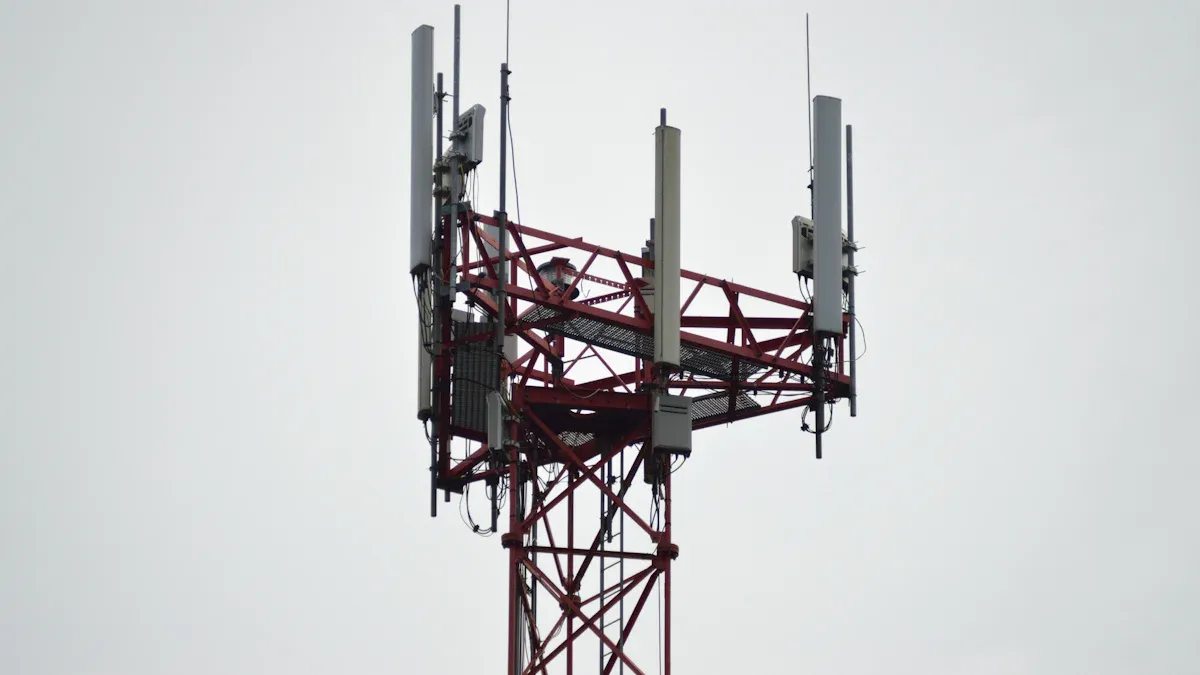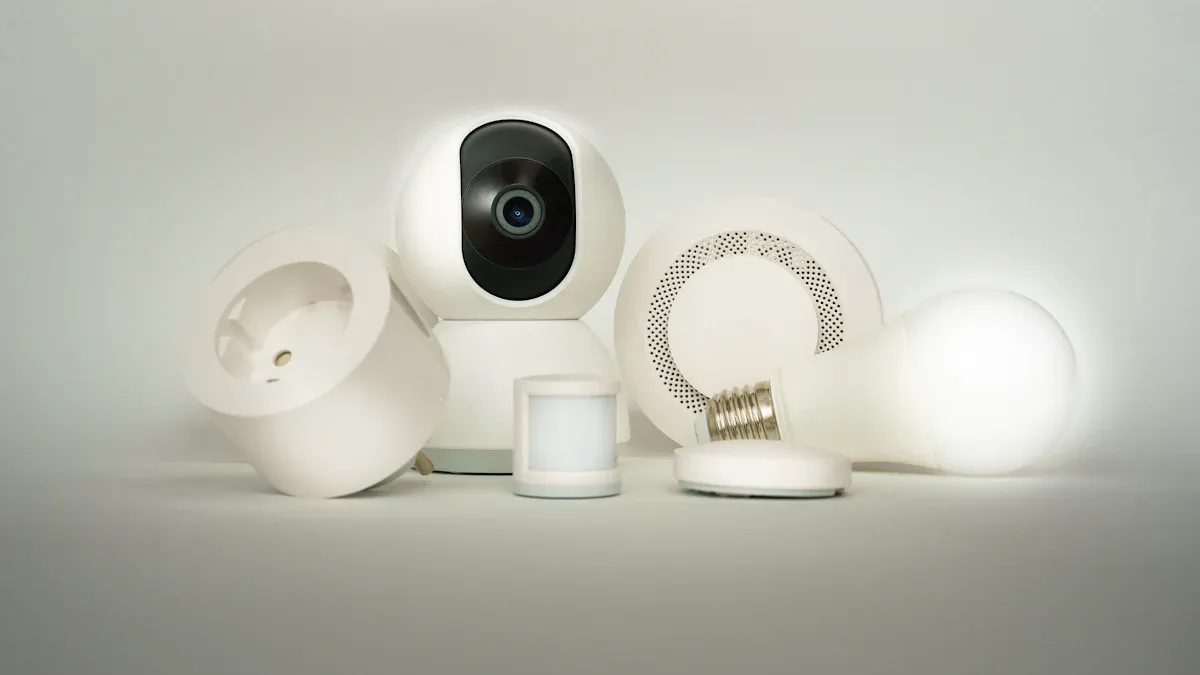
Smart home devices thrive on the 2.4GHz Wi-Fi band. Why? It offers better range and wall penetration than other bands, making it perfect for devices spread across your home. Many smart devices, especially older ones, only work on this band, and its compatibility ensures smooth operation.
However, dual-band routers can complicate things. Some devices struggle to connect unless the 5GHz band is turned off. Band steering, designed to help, often keeps devices on the crowded 2.4GHz band instead of the faster 5GHz. These issues can disrupt your smart home’s performance.
A proper setup is key. By optimizing your 2.4GHz router, you can avoid these challenges and enjoy seamless connectivity for your smart devices.
Identifying Your 2.4GHz Wi-Fi Network

Checking your router’s specifications for 2.4GHz support
Before setting up your smart devices, confirm that your router supports the 2.4GHz band. Most modern routers are dual-band, offering both 2.4GHz and 5GHz options. The 2.4GHz band is essential for smart devices because it provides better range and penetrates walls more effectively than 5GHz. This makes it ideal for devices located far from the router or separated by physical barriers.
To verify your router’s compatibility, check its specifications. Manufacturers often list supported bands in the product manual or on their website. For example:
| Hersteller | Modell | 2.4GHz Support |
|---|---|---|
| Cisco | 8000 Series Routers | Ja |
| TP-Link | AX6000 Next-Gen Wi-Fi Router | Ja |
If your router supports 2.4GHz, you’re ready to proceed with identifying the correct network for your smart devices.
Locating the 2.4GHz SSID in your router settings
Finding the 2.4GHz SSID (network name) is crucial for connecting your smart devices. Many routers merge the 2.4GHz and 5GHz bands under a single SSID, which can confuse devices during setup. To ensure a smooth connection, follow these steps:
- Access your router’s settings through its web interface or mobile app.
- Confirm that the SSID for the 2.4GHz band is being broadcast. If it’s merged with the 5GHz band, consider temporarily disabling the 5GHz option.
- Make sure the SSID is visible to your smart device. Some devices, like printers, only work with the 2.4GHz band.
Dual-band routers can face interference from nearby networks or household devices like microwaves and cordless phones. These factors can degrade performance, especially on the 2.4GHz band. If you live in a densely populated area, neighboring networks may also interfere with your connection.
Devices using 802.11b experience interference from other products operating in the 2.4GHz band, including microwave ovens, Bluetooth devices, and cordless telephones.
By ensuring the SSID is properly configured, you can minimize these challenges and improve connectivity.
Ensuring your mobile device is connected to the 2.4GHz band during setup
When setting up smart devices, your mobile phone must connect to the 2.4GHz band. Many devices won’t work if your phone is on the 5GHz band. Here’s how to make sure you’re on the right network:
- Split the Bands: Log into your router settings and create separate SSIDs for the 2.4GHz and 5GHz networks. This lets you choose the correct band during setup.
- Go the Distance: Move farther from the router. Phones often connect to the 2.4GHz band when the 5GHz signal weakens due to its shorter range.
- Create a Guest Network: If your router doesn’t allow band splitting, set up a guest network that operates exclusively on the 2.4GHz band. This simplifies the connection process for your smart devices.
By following these steps, you can ensure your mobile device connects to the 2.4GHz band, paving the way for a hassle-free setup of your smart home devices.
Configuring Your 2.4GHz Router for Smart Home Devices
Splitting bands into separate SSIDs for 2.4GHz and 5GHz
Separating the 2.4GHz and 5GHz bands into distinct SSIDs is one of the easiest ways to ensure your smart home devices connect to the right network. Many routers combine both bands under a single name, which can confuse devices during setup. Splitting them gives you full control over which band your devices use.
Here’s how you can do it:
- Log into your router settings: Open your router’s web interface or mobile app. You’ll usually find this by typing your router’s IP address into a browser.
- Locate the wireless settings: Look for an option to manage SSIDs or Wi-Fi bands.
- Rename the bands: Assign unique names to the 2.4GHz and 5GHz networks. For example, you could name them “Home_2.4GHz” and “Home_5GHz.”
- Save your changes: Once you’ve renamed the bands, save the settings and reconnect your devices to the appropriate network.
By splitting the bands, you make it easier for your smart home devices to find and stay connected to the 2.4GHz network. This step also helps you troubleshoot connectivity issues more effectively.
Tipp: Use simple and recognizable names for your networks to avoid confusion during setup.
Creating a dedicated guest network for smart home devices
A guest network isn’t just for visitors—it can be a lifesaver for your smart home setup. By creating a dedicated guest network that operates exclusively on the 2.4GHz band, you can isolate your smart home devices from your main network. This reduces interference and improves performance.
Here’s why a guest network is a great idea:
- Simplified setup: Smart home devices often struggle with dual-band networks. A guest network ensures they connect to the 2.4GHz band without interference from the 5GHz band.
- Enhanced security: Keeping your smart home devices on a separate network minimizes the risk of unauthorized access to your main network.
- Better organization: You can easily manage and monitor your smart devices when they’re grouped on a dedicated network.
To set up a guest network:
- Access your router settings: Navigate to the guest network section in your router’s interface.
- Enable the guest network: Turn on the feature and configure it to operate only on the 2.4GHz band.
- Set a password: Protect the network with a strong password to prevent unauthorized access.
- Connect your smart devices: Use the guest network for all your smart home devices during setup.
A dedicated guest network simplifies connectivity and ensures your smart home devices perform at their best.
Disabling band steering to prevent automatic switching
Band steering is a feature designed to optimize your Wi-Fi experience by automatically switching devices between the 2.4GHz and 5GHz bands. While this sounds helpful, it can cause problems for smart home devices that require a stable connection to the 2.4GHz network. Disabling band steering ensures your devices stay connected to the correct band.
Here’s how you can turn off band steering:
- Check your router settings: Look for an option labeled “Band Steering” or “Smart Connect.”
- Disable the feature: Toggle the setting off to prevent automatic switching between bands.
- Reconnect your devices: Once band steering is disabled, reconnect your smart home devices to the 2.4GHz network.
Disabling band steering gives you more control over your network and prevents connectivity issues. It’s especially useful if you have devices that frequently disconnect or fail to connect during setup.
Hinweis: Not all routers support disabling band steering. If your router doesn’t have this option, consider splitting the bands into separate SSIDs as an alternative.
Troubleshooting 2.4GHz Wi-Fi Connectivity Issues

Resolving SSID conflicts between 2.4GHz and 5GHz networks
SSID conflicts can confuse your smart devices, especially when both the 2.4GHz and 5GHz bands share the same network name. This often leads to devices connecting to the wrong band or failing to connect altogether. To fix this, you can rename the SSIDs for each band. For example, you might name one “Home_2.4GHz” and the other “Home_5GHz.” This makes it easier to identify and connect your devices to the correct network.
Another common issue arises when nearby networks use the same or overlapping channels. This can cause interference, especially in densely populated areas. Adjusting your router’s channel settings can help. Most routers default to automatic channel selection, but you can manually set it to a less crowded channel. Channels 1, 6, and 11 are often recommended for the 2.4GHz band because they don’t overlap.
Tipp: Use a Wi-Fi analyzer app to identify the least crowded channel in your area.
Adjusting router settings like channel width and signal strength
Fine-tuning your router’s settings can significantly improve your 2.4GHz connection. Start by adjusting the channel width. Most routers offer options like 20MHz or 40MHz. While 40MHz provides faster speeds, it’s more prone to interference. For better stability, stick with 20MHz, especially in areas with many overlapping networks.
Signal strength also plays a crucial role. If your router’s transmit power is too high, it can cause interference with nearby networks or even your own devices. Lowering the transmit power can reduce this overlap and improve performance. Additionally, ensure your router is placed in a central location, away from walls, metal objects, and other electronics like microwaves or Bluetooth devices.
Here’s a quick reference table for common issues and solutions:
| Issue Type | Lösungen |
|---|---|
| Co-channel interference | – Relocate APs, lower transmit power, or create a static channel plan. |
| Non-Wi-Fi interference | – Remove sources like microwaves and Bluetooth devices. |
| AP placement | – Space APs adequately to avoid overlap. |
| Transmit power too high | – Adjust transmit power to prevent excessive overlap. |
Restarting devices and router to refresh connections
Sometimes, the simplest solution is the most effective. Restarting your router and devices can resolve temporary glitches and improve your 2.4GHz connection. When you reboot your router, it clears its internal memory, resets any stuck processes, and refreshes the connection. This can fix issues like slow speeds or dropped connections.
To restart, unplug your router and modem, wait for about 30 seconds, and then plug them back in. For smart devices, turn them off and on again or use the reset option if available. Regularly scheduling restarts can also help maintain network health and prevent future issues.
| Evidence Description | Wichtige Punkte |
|---|---|
| Restarting your router and/or modem resets any temporary glitches and helps improve performance. | Schedule regular restarts to fix connection issues and maintain network health. |
| Rebooting clears out any temporary glitches or other major issues interfering with your connection. | Power cycle your modem and router to reset internal memory and eliminate glitches. Regular reboots keep connectivity stable. |
Profi-Tipp: If you frequently experience connectivity issues, consider setting up an automatic restart schedule for your router.
Additional Tips for Optimizing 2.4GHz Wi-Fi
Using WiFi extenders to improve 2.4GHz coverage
If your smart home devices struggle to stay connected, a WiFi extender can be a game-changer. These devices boost your network’s range, ensuring reliable coverage even in hard-to-reach areas like basements or outdoor spaces. Unlike WiFi repeaters, extenders use separate radios and channels for communication, which improves both signal strength and throughput.
Field tests by CableLabs showed that WiFi extenders enhanced the minimum received signal strength indicator (RSSI) to -50 dBm, compared to -58 dBm achieved by repeaters. This means extenders deliver stronger signals, especially in areas far from the router. They also reduce latency, making them ideal for smart home setups where consistent connectivity is crucial.
When choosing an extender, look for one compatible with your router and capable of supporting the 2.4GHz band. Place it midway between your router and the area needing coverage for the best results.
Tipp: If you have multiple smart home devices spread across your house, consider using more than one extender to ensure complete coverage.
Positioning smart devices farther from the router to avoid interference
Believe it or not, placing your smart home devices too close to the router can cause interference. Routers emit strong signals that can overwhelm nearby devices, leading to connectivity issues. Moving your devices slightly farther away can help them connect more reliably to the 2.4GHz band.
For optimal performance, position your devices at least a few feet away from the router. This reduces signal overlap and interference from other electronics like microwaves or cordless phones. If you’re setting up multiple devices, space them out to avoid crowding the network.
Optimize Access Point Placement: Place access points centrally and away from obstructions to enhance coverage.
This simple adjustment can make a big difference in your smart home’s connectivity and overall performance.
Ensuring firmware updates for both router and smart devices
Firmware updates are like tune-ups for your router and smart home devices. They fix bugs, improve security, and optimize performance. Regular updates ensure your devices stay compatible with the latest technology and maintain a stable connection to the 2.4GHz band.
Here are some real-world examples of the benefits of firmware updates:
- Enhanced Home Network Performance: A tech enthusiast improved his router’s efficiency using OpenWrt, creating a faster and more secure network.
- Small Business Network Optimization: A business owner upgraded her router firmware, boosting productivity and reliability in her office.
- Community Wi-Fi Projects: Volunteers used Tomato firmware to provide internet access in underserved areas, ensuring fair resource distribution.
To update your firmware, check your router’s settings or the manufacturer’s website for instructions. Many smart home devices also offer automatic updates, so enable this feature whenever possible.
Profi-Tipp: Schedule regular firmware checks to keep your network running smoothly and avoid unexpected connectivity issues.
Leveraging Huasifei Networking Solutions
Benefits of Huasifei’s advanced 2.4GHz routers for smart home setups
Huasifei’s 2.4GHz routers are designed to make your smart home installation easier and more reliable. These routers excel at covering large areas, which is perfect for homes with multiple smart devices. The 2.4GHz band penetrates walls effectively, ensuring your devices stay connected even in rooms far from the router.
You’ll find these routers ideal for basic tasks like connecting IoT devices or browsing the web. They don’t require high speeds, so the 2.4GHz band works seamlessly for them. Plus, older smart devices often rely on this band, and Huasifei’s routers ensure compatibility across a wide range of products.
Tipp: If you’re setting up a smart home with devices spread across multiple floors, Huasifei’s routers can provide the stable connection you need.
Exploring Huasifei’s Wi-Fi extenders and network bridges for enhanced connectivity
Sometimes, your smart devices need a little extra help to stay connected. That’s where Huasifei’s Wi-Fi extenders and network bridges come in. These tools expand your 2.4GHz coverage, eliminating dead zones and ensuring every corner of your home gets a strong signal.
Wi-Fi extenders boost the signal strength, making it easier for devices in hard-to-reach areas to connect. Network bridges, on the other hand, create a seamless link between different parts of your network. This is especially useful if you have outdoor smart devices or a detached garage that needs connectivity.
- Why Choose Huasifei Extenders and Bridges?
- They improve signal reliability for 2.4GHz devices.
- They reduce latency, which is crucial for smart home automation.
- They simplify installation, saving you time and effort.
Profi-Tipp: Place your extender midway between your router and the area needing coverage for the best results.
How Huasifei’s expertise in IoT solutions can simplify smart home integration
Huasifei doesn’t just offer products; they provide solutions tailored to your smart home needs. Their expertise in IoT ensures that your devices connect effortlessly to the 2.4GHz band. Whether you’re installing smart lights, cameras, or thermostats, Huasifei’s technology makes the process smooth and stress-free.
Their focus on innovation means you get cutting-edge features that enhance your smart home experience. For example, their routers and extenders are optimized for IoT devices, ensuring stable connections and minimal interference. With Huasifei, you can trust that your smart home setup will work flawlessly.
Hinweis: Huasifei’s commitment to quality and customer satisfaction has made them a trusted name in over 30 countries.
Setting up your smart home starts with understanding your 2.4GHz Wi-Fi network. Identifying the right band ensures your devices connect reliably, while configuring your router optimizes performance. Troubleshooting common issues, like SSID conflicts or signal interference, keeps your network running smoothly.
Profi-Tipp: Restarting your router regularly can fix temporary glitches and improve connectivity.
Huasifei’s advanced networking solutions make this process even easier. Their routers, extenders, and IoT expertise simplify smart home integration, ensuring your devices stay connected and perform at their best. With Huasifei, you can enjoy a seamless smart home experience.
FAQ
How can I change WiFi to 2.4GHz for my smart devices?
Log into your router’s settings using its IP address. Look for wireless settings and split the bands into separate SSIDs. Rename the 2.4GHz Wi-Fi network name to something unique. Connect your smart devices to this network during setup for a stable connection.
Why do smart devices prefer 2.4GHz Wi-Fi over 5GHz?
The 2.4GHz Wi-Fi band offers better range and penetrates walls more effectively. This makes it ideal for smart devices spread across your home. It ensures a long range and stable connection, especially for devices located far from the router.
What should I do if my smart device connection fails during setup?
Ensure your mobile device connects to the 2.4GHz Wi-Fi network name. Restart your router and smart devices to refresh the connection. If the issue persists, disable band steering or adjust the router’s channel settings to reduce interference.
Can I use a guest network for smart devices?
Yes, creating a guest network exclusively on the 2.4GHz band simplifies setup and improves performance. It isolates smart devices from your main network, reducing interference and enhancing security. Access your router’s settings to enable this feature.
How do WiFi extenders help with smart device connection?
WiFi extenders boost the signal strength of your 2.4GHz Wi-Fi, ensuring smart devices in hard-to-reach areas stay connected. Place the extender midway between your router and the devices for optimal coverage. This improves the connection and eliminates dead zones.